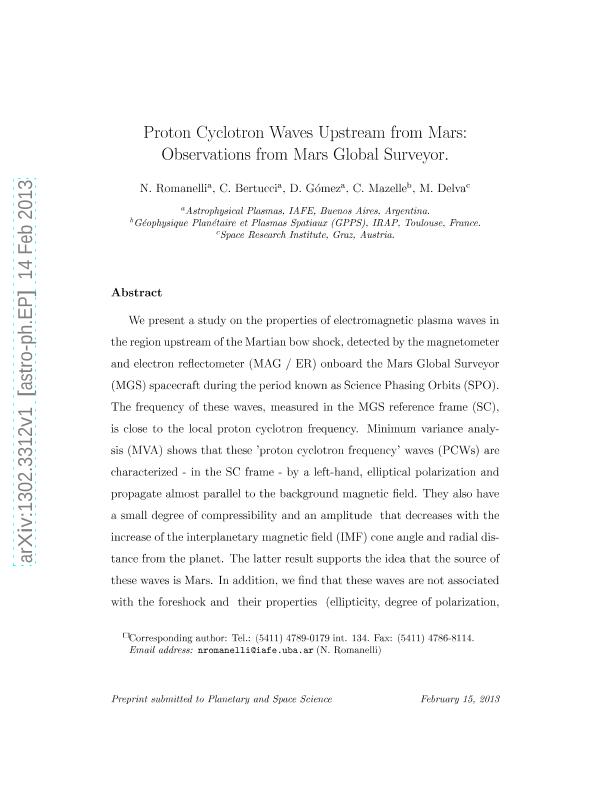Mostrar el registro sencillo del ítem
dc.contributor.author
Romanelli, Norberto Julio

dc.contributor.author
Bertucci, Cesar

dc.contributor.author
Gomez, Daniel Osvaldo

dc.contributor.author
Mazelle, C.
dc.contributor.author
Delva, M.
dc.date.available
2017-05-29T19:04:39Z
dc.date.issued
2013-02
dc.identifier.citation
Romanelli, Norberto Julio; Bertucci, Cesar; Gomez, Daniel Osvaldo; Mazelle, C.; Delva, M.; Proton cyclotron waves upstream from Mars: Observations from Mars Global Surveyor; Elsevier; Planetary And Space Science; 76; 1; 2-2013; 1-9
dc.identifier.issn
0032-0633
dc.identifier.uri
http://hdl.handle.net/11336/17084
dc.description.abstract
We present a study on the properties of electromagnetic plasma waves in the region upstream of the Martian bow shock, detected by the magnetometer and electron reflectometer (MAG / ER) onboard the Mars Global Surveyor (MGS) spacecraft during the period known as Science Phasing Orbits (SPO). The
frequency of these waves, measured in the MGS reference frame (SC), is close to the local proton cyclotron frequency. Minimum variance analysis (MVA) shows that these ‘proton cyclotron frequency’ waves (PCWs) are characterized – in the SC frame – by a left-hand, elliptical polarization and propagate almost parallel to the background magnetic field. They also have a small degree of compressibility and
an amplitude that decreases with the increase of the interplanetary magnetic field (IMF) cone angle and radial distance from the planet. The latter result supports the idea that the source of these waves is Mars. In addition, we find that these waves are not associated with the foreshock and their properties (ellipticity, degree of polarization, direction of propagation) do not depend on the IMF cone angle.
Empirical evidence and theoretical approaches suggest that most of these observations correspond to the ion–ion right hand (RH) mode originating from the pick-up of ionized exospheric hydrogen. The left-hand (LH) mode might be present in cases where the IMF is almost perpendicular to the Solar Wind direction. PCWs occur in 62% of the time during SPO1 subphase, whereas occurrence drops to 8% during SPO2. Also, SPO1 PCWs preserve their characteristics for longer time periods and have greater degree of polarization and coherence than those in SPO2. We discuss these results in the context of possible changes in the pick-up conditions from SPO1 to SPO2, or steady, spatial inhomogeneities in the wave
distribution. The lack of influence from the Solar Wind’s convective electric field upon the location of PCWs indicates that, as suggested by recent theoretical results, there is no clear relation between the spatial distribution of PCWs and that of pick-up ions.
dc.format
application/pdf
dc.language.iso
eng
dc.publisher
Elsevier

dc.rights
info:eu-repo/semantics/openAccess
dc.rights.uri
https://creativecommons.org/licenses/by-nc-nd/2.5/ar/
dc.subject
Mars
dc.subject
Upstream
dc.subject
Waves
dc.subject
Pick-Up
dc.subject
Exosphere
dc.subject.classification
Astronomía

dc.subject.classification
Ciencias Físicas

dc.subject.classification
CIENCIAS NATURALES Y EXACTAS

dc.title
Proton cyclotron waves upstream from Mars: Observations from Mars Global Surveyor
dc.type
info:eu-repo/semantics/article
dc.type
info:ar-repo/semantics/artículo
dc.type
info:eu-repo/semantics/publishedVersion
dc.date.updated
2017-05-23T19:17:10Z
dc.journal.volume
76
dc.journal.number
1
dc.journal.pagination
1-9
dc.journal.pais
Países Bajos

dc.journal.ciudad
Amsterdam
dc.description.fil
Fil: Romanelli, Norberto Julio. Consejo Nacional de Investigaciónes Científicas y Técnicas. Oficina de Coordinación Administrativa Ciudad Universitaria. Instituto de Astronomía y Física del Espacio. - Universidad de Buenos Aires. Facultad de Ciencias Exactas y Naturales. Instituto de Astronomía y Física del Espacio; Argentina
dc.description.fil
Fil: Bertucci, Cesar. Consejo Nacional de Investigaciónes Científicas y Técnicas. Oficina de Coordinación Administrativa Ciudad Universitaria. Instituto de Astronomía y Física del Espacio. - Universidad de Buenos Aires. Facultad de Ciencias Exactas y Naturales. Instituto de Astronomía y Física del Espacio; Argentina
dc.description.fil
Fil: Gomez, Daniel Osvaldo. Consejo Nacional de Investigaciónes Científicas y Técnicas. Oficina de Coordinación Administrativa Ciudad Universitaria. Instituto de Astronomía y Física del Espacio. - Universidad de Buenos Aires. Facultad de Ciencias Exactas y Naturales. Instituto de Astronomía y Física del Espacio; Argentina
dc.description.fil
Fil: Mazelle, C.. Geophysique Planetaire et Plasmas Spatiaux ; Francia
dc.description.fil
Fil: Delva, M.. Space Research Institute; Austria
dc.journal.title
Planetary And Space Science

dc.relation.alternativeid
info:eu-repo/semantics/altIdentifier/doi/http://dx.doi.org/10.1016/j.pss.2012.10.011
dc.relation.alternativeid
info:eu-repo/semantics/altIdentifier/url/http://www.sciencedirect.com/science/article/pii/S0032063312003029
dc.relation.alternativeid
info:eu-repo/semantics/altIdentifier/arxiv/https://arxiv.org/abs/1302.3312
Archivos asociados
